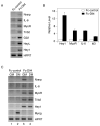Inhibition of myogenesis by Notch: evidence for multiple pathways
- PMID: 18727102
- PMCID: PMC4281488
- DOI: 10.1002/jcp.21571
Inhibition of myogenesis by Notch: evidence for multiple pathways
Abstract
Notch signaling is critical for skeletal muscle development and regeneration, permitting the expansion of progenitor cells by preventing premature differentiation. We have interrogated the pathways through which ligand-mediated signaling inhibits myogenesis by identifying Notch target genes and assessing their impact on differentiation in vitro. Notch activation led to the robust induction of the transcriptional repressors Hey1 and HeyL in myoblasts, but only constitutive expression of Hey1 blocked myogenesis. siRNA-mediated knockdown of Hey1 had no effect on Notch's ability to inhibit differentiation, suggesting the existence of additional, possibly redundant pathways. We identified 82 genes whose expression was activated when C2C12 myoblasts were cultured in the presence of the Notch ligand Dll4. One of these, MyoR, is a novel Notch-responsive gene, whose protein product is known to repress myogenesis in vitro. siRNA-mediated knockdown of MyoR alone, or in combination with Hey1, was also ineffective at rescuing differentiation in the presence of Dll4. Our data support a model in which Notch signaling inhibits myogenesis through multiple pathways, two of which are defined by the Notch target genes Hey1 and MyoR.
(c) 2008 Wiley-Liss, Inc.
Figures







Similar articles
-
Inhibition of the Notch-Hey1 axis blocks embryonal rhabdomyosarcoma tumorigenesis.Clin Cancer Res. 2011 Dec 1;17(23):7324-36. doi: 10.1158/1078-0432.CCR-11-1004. Epub 2011 Sep 23. Clin Cancer Res. 2011. PMID: 21948088 Free PMC article.
-
The Notch effector Hey1 associates with myogenic target genes to repress myogenesis.J Biol Chem. 2010 Jan 8;285(2):1249-58. doi: 10.1074/jbc.M109.046441. Epub 2009 Nov 16. J Biol Chem. 2010. PMID: 19917614 Free PMC article.
-
Coordinated activation of notch, Wnt, and transforming growth factor-beta signaling pathways in bone morphogenic protein 2-induced osteogenesis. Notch target gene Hey1 inhibits mineralization and Runx2 transcriptional activity.J Biol Chem. 2004 Sep 3;279(36):37704-15. doi: 10.1074/jbc.M403813200. Epub 2004 Jun 2. J Biol Chem. 2004. PMID: 15178686
-
Notch function in myogenesis.Cell Cycle. 2007 Jun 15;6(12):1451-4. Epub 2007 May 2. Cell Cycle. 2007. PMID: 17581278 Review.
-
Roles of Endothelial Hrt Genes for Vascular Development.2016 Jun 25. In: Nakanishi T, Markwald RR, Baldwin HS, Keller BB, Srivastava D, Yamagishi H, editors. Etiology and Morphogenesis of Congenital Heart Disease: From Gene Function and Cellular Interaction to Morphology [Internet]. Tokyo: Springer; 2016. Chapter 31. 2016 Jun 25. In: Nakanishi T, Markwald RR, Baldwin HS, Keller BB, Srivastava D, Yamagishi H, editors. Etiology and Morphogenesis of Congenital Heart Disease: From Gene Function and Cellular Interaction to Morphology [Internet]. Tokyo: Springer; 2016. Chapter 31. PMID: 29787137 Free Books & Documents. Review.
Cited by
-
Inhibition of the Notch-Hey1 axis blocks embryonal rhabdomyosarcoma tumorigenesis.Clin Cancer Res. 2011 Dec 1;17(23):7324-36. doi: 10.1158/1078-0432.CCR-11-1004. Epub 2011 Sep 23. Clin Cancer Res. 2011. PMID: 21948088 Free PMC article.
-
Bone marrow-induced Mef2c deficiency delays B-cell development and alters the expression of key B-cell regulatory proteins.Int Immunol. 2013 Feb;25(2):99-115. doi: 10.1093/intimm/dxs088. Epub 2012 Oct 19. Int Immunol. 2013. PMID: 23087187 Free PMC article.
-
Dynamic binding of RBPJ is determined by Notch signaling status.Genes Dev. 2013 May 1;27(9):1059-71. doi: 10.1101/gad.211912.112. Genes Dev. 2013. PMID: 23651858 Free PMC article.
-
The role of Notch signaling in muscle progenitor cell depletion and the rapid onset of histopathology in muscular dystrophy.Hum Mol Genet. 2015 May 15;24(10):2923-37. doi: 10.1093/hmg/ddv055. Epub 2015 Feb 12. Hum Mol Genet. 2015. PMID: 25678553 Free PMC article.
-
RNA-Seq analysis of a Pax3-expressing myoblast clone in-vitro and effect of culture surface stiffness on differentiation.Sci Rep. 2022 Feb 18;12(1):2841. doi: 10.1038/s41598-022-06795-3. Sci Rep. 2022. PMID: 35181706 Free PMC article.
References
-
- Artavanis-Tsakonas S, Rand MD, Lake RJ. Notch signaling: cell fate control and signal integration in development. Science. 1999;284(5415):770–776. - PubMed
-
- Atherton GT, Travers H, Deed R, Norton JD. Regulation of cell differentiation in C2C12 myoblasts by the Id3 helix-loop-helix protein. Cell Growth Differ. 1996;7(8):1059–1066. - PubMed
-
- Cantini M, Massimino ML, Rapizzi E, Rossini K, Catani C, Dalla Libera L, Carraro U. Human satellite cell proliferation in vitro is regulated by autocrine secretion of IL-6 stimulated by a soluble factor(s) released by activated monocytes. Biochem Biophys Res Commun. 1995;216(1):49–53. - PubMed
-
- Cheng TC, Wallace MC, Merlie JP, Olson EN. Separable regulatory elements governing myogenin transcription in mouse embryogenesis. Science. 1993;261(5118):215–218. - PubMed
-
- Conboy IM, Conboy MJ, Smythe GM, Rando TA. Notch-mediated restoration of regenerative potential to aged muscle. Science. 2003;302(5650):1575–1577. - PubMed
Publication types
MeSH terms
Substances
Grants and funding
LinkOut - more resources
Full Text Sources
Other Literature Sources

